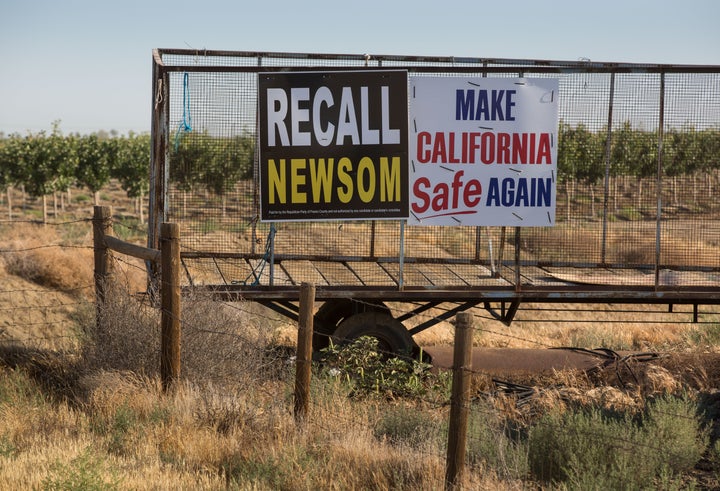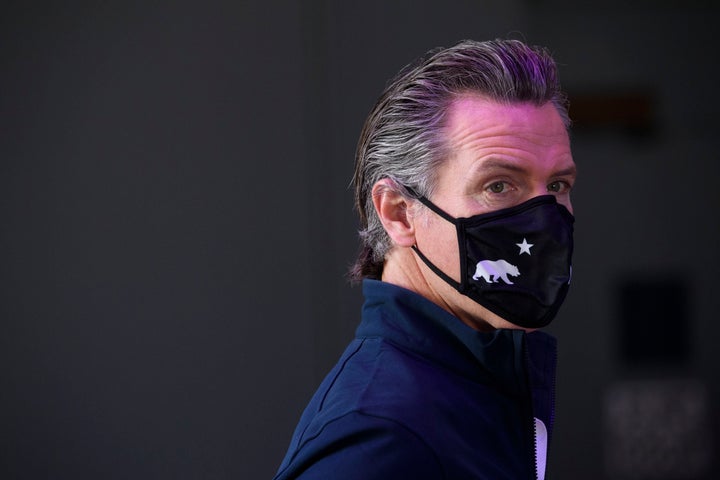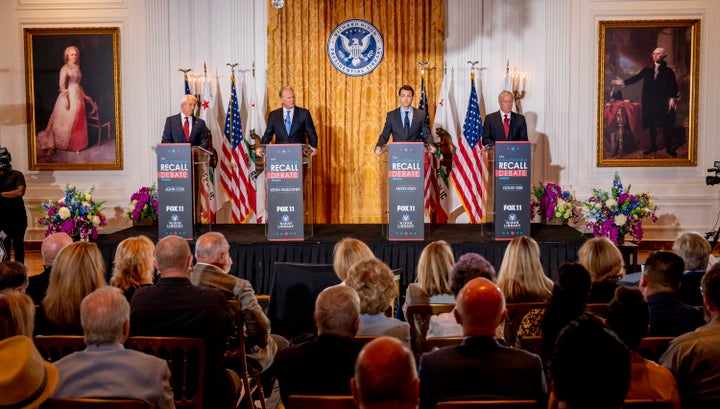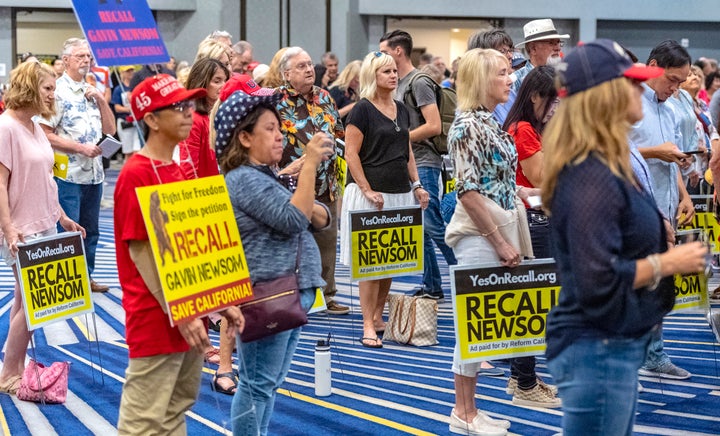For the second time in history, California voters will have the opportunity to oust their governor from office and pick a replacement from a lengthy list of aspiring leaders.
The recall election on Sept. 14 ― an ordeal that’s costing taxpayers $276 million ― could upend Democratic Gov. Gavin Newsom’s political future and change the course of California history. But the process, stakes and possible outcomes of the recall election aren’t widely understood.
Here’s what you need to know.

Why is this happening?
California is one of 19 states that allow recall elections, and Golden State residents have long tried to take advantage of the opportunity to oust their leader. Every governor since 1960, whether Democrat or Republican, has faced multiple recall attempts, but the efforts rarely gain enough steam to capture any attention, let alone trigger an election.
Every once in a while, though, there is an exception. In 2003, a gubernatorial recall qualified for the state’s ballot for the first time, and Gov. Gray Davis (D) was ultimately removed by Californians angry over an electricity crisis and increased car registration fees. Now, less than two decades later, a recall campaign has made it onto the ballot again, and Newsom has to put up the same fight Davis once did.
To get their recall efforts on the ballot, Newsom’s opponents needed to collect signatures from 12% of the number of voters in the last election for governor, which comes out to just shy of 1.5 million people. Compared to other states that allow recalls, 12% is a low bar; most other states require roughly double that percentage.
In April, election officials verified 1.626 million signatures submitted by a former county sheriff’s sergeant from Folsom, a city in Sacramento County that skews Republican.
That former officer, Orrin Heatlie, first had the idea for a recall attempt in 2019, after he saw a video of Newsom telling undocumented immigrants they didn’t have to open their doors to law enforcement officers without a warrant. Policing in immigration, however, wouldn’t end up playing much of a role in the success of Heatlie’s campaign.
Why was this campaign for a recall election successful?
In short: the COVID-19 pandemic.
Several elements of the ongoing crisis ― some within Newsom’s control, others not ― gave the once-unlikely recall effort a major boost. Most notably, Judge James Arguelles awarded the recall campaign a 120-day extension of the usual 160-day signature-collecting period in November, arguing that it was “virtually, if not actually impossible for petitioners to gather enough signatures under current conditions” of the pandemic.
It later came out that Arguelles, a nominee of former President Donald Trump, was once law partners with the attorney hired by the recall campaign, raising concerns about a possible conflict of interest. However, Arguelles had also granted signature collection extensions for two Democratic-backed initiatives earlier in 2020.

The California secretary of state’s office had the option to appeal Arguelles’ decision, but it never did. “I just think it got lost in the shuffle,” Garry South, a Democratic political consultant, told The Sacramento Bee.
The extension came through just as Newsom’s popularity was foundering. Many of his critics disagreed with his pandemic shutdown decisions, particularly school closures, compared to some other states’ more relaxed opening procedures ― a frustration that became one of the main rallying cries of the recall campaign. Unhappy business owners saw the restrictions, which ranged from complete closures and limited-capacity operations to outdoor-only policies and mask mandates, as heavy-handed. But Newsom maintained that he was following the science, and urged his constituents to be patient as the vaccine rollout would soon be ramping up.
Then, just days after the extension was granted, damning photos emerged of Newsom dining in a semi-enclosed restaurant space ― at the ultra-exclusive French Laundry in Napa, no less ― with a dozen guests from multiple households. There was no clear consensus on whether Newsom was violating his own rules, which were somewhat murky regarding such gatherings at restaurants, but Californians across the political spectrum were outraged. Newsom apologized, saying: “You can quibble about the guidelines, but the spirit of what I’m preaching all the time was contradicted. I’ve got to own that.”
Newsom’s popularity would shoot back up to normal levels in the following months as pandemic conditions drastically improved, mass vaccine rollout began and schools and business reopened. But by that point, the signatures had been gathered, and it was clear in early 2021 that Newsom would face a recall.
How will the recall election work?
The idea of a recall election may sound strange to many Americans. Fewer than half the states allow them, and they’re quite rare. This is only the fifth time in U.S. history that a gubernatorial recall effort has successfully qualified for the ballot.
The Sept. 14 ballot ― which all registered voters will also receive by mail in August ― will ask California voters two simple questions: Do they want to recall Newsom? And if he is recalled, who do they want to replace him with?

If more than 50% of voters support recalling Newsom, then whoever has the most votes as his replacement will take over as governor and finish Newsom’s term, which is up in early 2023. It doesn’t matter how low the winner’s share of the vote is, as long as it’s higher than any other candidate’s.
Arnold Schwarzenegger became California’s governor in 2003 with 48.6% of the vote in the recall election against Davis, whom 55.4% of Californians came out in favor of recalling. With the current pool of opponents, it’s possible that someone running to unseat Newsom could do so with just 25% of voters supporting them, The Associated Press found.
Doesn’t sound very fair? Well, that’s because it’s not, some have argued. The Los Angeles Times editorial board said in early August that the current recall system is “not just perilous for the state’s stability, it’s undemocratic,” and called for a complete overhaul of the arrangement.
Who’s running, and what are their chances?
More than 40 people have thrown their hats in the ring. The nature of the recall ― its expedited timeline, the ability to win with a low share of votes and the media attention that comes with it ― is often alluring to atypical candidates, be they an Austrian bodybuilder-turned-actor, an Olympian-turned-reality television star or even a founder of HuffPost.
California is blue ― bluer than it was during the 2003 recall ― and there are no serious Democratic challengers, which is to Newsom’s benefit. If he’s unseated, it will most likely be by one of the better-known Republicans in the pool.
Among those opponents, conservative talk radio host Larry Elder has the most support. According to a late-July poll from the Institute of Governmental Studies at the University of California, Berkeley, 18% of respondents are planning to vote for Elder. But among likely voters, that figure rises to 34%.
The other Republicans trail Elder significantly. John Cox, a businessman and conservative activist, and Kevin Faulconer, the former mayor of San Diego who skews more moderate, each had 10% of respondents say they plan to vote for them.
Caitlyn Jenner, the Olympian-turned-reality TV star, is the most recognizable name in the lot, but that doesn’t seem to be working for her as well as it did for Schwarzenegger in 2003. Just 3% of respondents say they are planning to support her in the recall, according to the poll.

Democrats with any degree of name recognition or policy experience who are running include Joel Ventresca, who worked on San Francisco’s aging and airport commissions; Michael Loebs, a political science lecturer and advocate for California’s secession from the U.S.; and Kevin Paffrath, a real estate broker and successful YouTube personality.
So, should Newsom be worried?
Yes. Even setting aside the tricky nature of the recall system, the numbers are not trending in the direction he needs.
Newsom’s popularity has crept back up to normal levels, but the recall effort, once seen as a long shot, has gained steam in recent weeks, and the latest polls show a tightening race. Both the UC Berkeley poll and another recent one from Emerson College/Nexstar Media found that the likelihoods of Newsom staying or being recalled are now within just a few points of each other, shrinking from a 10-point gap in May.
For Newsom, winning would hinge on strong Democratic voter turnout. Unfortunately for him, Republicans appear more enthusiastic about this election. In the UC Berkeley poll, 80% of Republican registered voters said they were absolutely certain to vote, while only 55% of Democrats and about half of independents said the same.
The governor also can’t rely too much on a boost from businesses and schools reopening, as his pandemic response is far from the only thing riling up his opponents. There was a slightly larger share of respondents in the UC Berkeley poll who cited Newsom’s failure to “adequately address many of the state’s longstanding problems,” like homelessness, income inequality and wildfires, as a reason to recall him than there were those who cited his pandemic response.
Newsom’s campaign must contend with one other snafu: He won’t actually appear on the ballot as a Democrat. His campaign accidentally missed the deadline to identify him by party, and Arguelles ― the same judge who granted the signature-collecting extension in November ― won’t let Newsom’s team correct its error.
None of this means a recall is a sure thing, but it’s certainly not out of the question.

It’s not all ominous for Newsom. He has the advantage of being the only serious Democrat in the race in a deeply blue state, and voter turnout may be higher than expected because the state is sending mail-in ballots out to every registered voter ― a policy that was put in place last year because of the pandemic and extended through 2021. If the voter turnout more closely mirrors the state’s Democratic majority, Newsom will be in luck.
What’s Newsom’s strategy?
Newsom has tried to stay above the fray since the recall effort got serious last year. For months he brushed off questions about the matter, saying his focus was squarely on helping California recover from the pandemic. Opponents going against him, Newsom spokesperson Dan Newman told HuffPost earlier this year, are simply trying to “exploit a global pandemic to advance a political career.”
The governor’s team began running its first three anti-recall ads in June. One highlights his state-funded stimulus checks and cash prizes related to the vaccine rollout. The others, one in English and one in Spanish, attempt to tie the recall effort to Republican extremism.
Newsom’s camp, which has far outraised his opponents, also tapped Sen. Elizabeth Warren (D-Mass.) to appear in an ad supporting him. In that ad, Warren, a favorite among progressives, compares the recall campaign to GOP lawmakers challenging election results, and describes it as “the Republican recall.” The Warren spot is running in every California market as their primary ad for the moment, the campaign has said.
Linking the recall effort to Trump, who is wildly unpopular in California, may be wise. Most of Newsom’s prominent opponents have supported the former president at one time or another, though some have since come out against him.
Vice President Kamala Harris, a longtime ally of Newsom who worked alongside him in San Francisco politics during the early aughts, has said she will also campaign in support of the governor.
As for the wider party strategy, Democrats are taking a calculated risk by not fielding an alternative Democrat. Doing so would have at least made it possible that if more than half of voters chose to recall Newsom, the victory wouldn’t automatically go to a Republican.

But creating those high stakes appears to be part of the Democrats’ strategy. If you don’t want a Republican governor, the implication seems to be, you absolutely must vote against the recall.
Newsom also recently urged voters not to bother with the second question on the recall ballot, which asks people to pick a replacement.
“We’re just focusing on ‘no’ on the recall, leaving the rest blank,” he said.
What’s at stake if Newsom is recalled?
The candidates most likely to replace Newsom are all conservative. Elder, the leading opponent, has expressed skepticism about the link between climate change and the state’s catastrophic wildfires. He opposes COVID-19 mask and vaccine mandates and believes that “abortion is murder,” he recently told the LA Times. He also disagrees that racism is a major problem in the U.S., supports a tough-on-crime approach and has boasted about his endorsement from a man who was arrested for his alleged involvement in the Jan. 6 riot on Capitol Hill.
If elected, Elder would make history as the first Black governor of California.
Of course, there’s only so much Elder could accomplish with a Democratic supermajority in both chambers of the state legislature, which makes any bills they pass immune from a governor’s veto.
But a successful recall of Newsom could prompt similar efforts in other states, and such attempts have already been happening at higher rates than ever.
And if Sen. Dianne Feinstein (D-Calif.), who is 88, were to retire with a Republican governor in office before her term ends, it would give the GOP a chance to appoint her replacement and, presumably, regain a majority in the U.S. Senate.
Newsom has also raised concern that a successful recall could damage people’s faith in California’s progressive principles.
Those values “would be judged in a different light if this was a successful recall,” he said earlier this month. “I think it would have profound consequences nationwide.”
